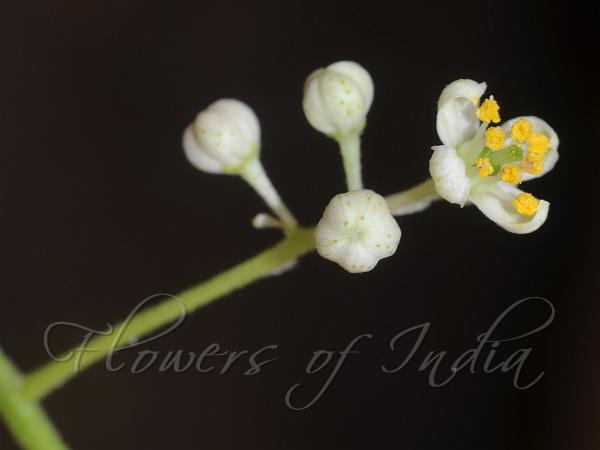|
| Horsewood |
|

|

| File size | 209886 |
| Original date | 6/4/16 8:14 AM |
| Resolution | 0 x 0 |
| Flash | Flash fired, return detected |
| Focal length | 60.0mm |
| Exposure time | 1/160s |
| Aperture | 11.0 |
| Focus Distance | |
| Metering Mode | Multi-segment |
| Camera make | NIKON CORPORATION |
| Camera model | NIKON D5100 |
| Sensor type | OneChipColorArea |
|
|
|
|
Photo: |
Botanical name: Clausena anisata Family: Rutaceae (Lemon family)
Synonyms: Clausena odorata, Clausena longipes
Synonyms: Clausena odorata, Clausena longipes
Horsewood is a small tree with bark reddish brown,
scaly; blaze pink. Young branchlets are round, grey velvet-hairy.
Leaves are compound, usually imparipinnate, sometimes paripinnate,
clustered at twig ends, alternate, spiral, 13-26 cm long; axis round,
grey velvet-hairy, sometimes becoming hairless. Leaflet-stalk is 0.2 cm
long; leaflets 7-13 pairs, 2.5-8 x 1.3-3.5 cm, generally increase in
size towards tip, ovate with unequal sides, tip tapering with retuse
tip, base asymmetric, margin entire to crenulate, chartaceous,
glandular punctuate, usually grey velvet-hairy on nerves and midrib on
both surfaces, sometimes becoming hairless; midrib raised above;
secondary nerves 7-11 pairs. Flowers are borne in leaf-axils, in
racemes. Flowers are white, 4-merous. Berry is spherical, 1.3 cm
across; seeds oblong. Dried leaves are widely used as an arthropod
repellent, such as a filling material for mattresses and pillows
against fleas, lice and bedbugs. The fruits are sweet and readily eaten
by people and other animals. Stem bark is pounded and used as rope.
Horsewood is found in India, Sri Lamka and Indo-Malaysia.
Medicinal uses: Horsewood is used in treating
a wide range of ailments and conditions. Decoctions of the leaves or
roots are taken for gastro-intestinal disorders, fever, pneumonia,
headache, hypotension, sore throat and sinusitis, venereal diseases, as
an aphrodisiac and anthelmintic, as a tonic for pregnant women, and as
a tonic for infants to prevent rickets and to control convulsions. Root
decoctions and infusions are also taken for whooping cough, malaria,
syphilis and kidney ailments, irregular menses, threatening abortion,
skin diseases and epilepsy, and given to women before and after
parturition to ease delivery and to expel blood from the uterus, and
later to boost milk production. Roots are chewed to combat indigestion.
Crushed leaves are used as an antiseptic and analgesic, and are applied
to open wounds, mouth infections, otitis and abscesses, also burns,
haemorrhoids, rheumatism and general body pains. Crushed leaves are
also used to treat wounds in domestic animals, and as a snake-bite
antidote.
Horsewood is used in treating
a wide range of ailments and conditions. Decoctions of the leaves or
roots are taken for gastro-intestinal disorders, fever, pneumonia,
headache, hypotension, sore throat and sinusitis, venereal diseases, as
an aphrodisiac and anthelmintic, as a tonic for pregnant women, and as
a tonic for infants to prevent rickets and to control convulsions. Root
decoctions and infusions are also taken for whooping cough, malaria,
syphilis and kidney ailments, irregular menses, threatening abortion,
skin diseases and epilepsy, and given to women before and after
parturition to ease delivery and to expel blood from the uterus, and
later to boost milk production. Roots are chewed to combat indigestion.
Crushed leaves are used as an antiseptic and analgesic, and are applied
to open wounds, mouth infections, otitis and abscesses, also burns,
haemorrhoids, rheumatism and general body pains. Crushed leaves are
also used to treat wounds in domestic animals, and as a snake-bite
antidote.
Medicinal uses:
 Horsewood is used in treating
a wide range of ailments and conditions. Decoctions of the leaves or
roots are taken for gastro-intestinal disorders, fever, pneumonia,
headache, hypotension, sore throat and sinusitis, venereal diseases, as
an aphrodisiac and anthelmintic, as a tonic for pregnant women, and as
a tonic for infants to prevent rickets and to control convulsions. Root
decoctions and infusions are also taken for whooping cough, malaria,
syphilis and kidney ailments, irregular menses, threatening abortion,
skin diseases and epilepsy, and given to women before and after
parturition to ease delivery and to expel blood from the uterus, and
later to boost milk production. Roots are chewed to combat indigestion.
Crushed leaves are used as an antiseptic and analgesic, and are applied
to open wounds, mouth infections, otitis and abscesses, also burns,
haemorrhoids, rheumatism and general body pains. Crushed leaves are
also used to treat wounds in domestic animals, and as a snake-bite
antidote.
Horsewood is used in treating
a wide range of ailments and conditions. Decoctions of the leaves or
roots are taken for gastro-intestinal disorders, fever, pneumonia,
headache, hypotension, sore throat and sinusitis, venereal diseases, as
an aphrodisiac and anthelmintic, as a tonic for pregnant women, and as
a tonic for infants to prevent rickets and to control convulsions. Root
decoctions and infusions are also taken for whooping cough, malaria,
syphilis and kidney ailments, irregular menses, threatening abortion,
skin diseases and epilepsy, and given to women before and after
parturition to ease delivery and to expel blood from the uterus, and
later to boost milk production. Roots are chewed to combat indigestion.
Crushed leaves are used as an antiseptic and analgesic, and are applied
to open wounds, mouth infections, otitis and abscesses, also burns,
haemorrhoids, rheumatism and general body pains. Crushed leaves are
also used to treat wounds in domestic animals, and as a snake-bite
antidote. | Identification credit: Anurag Sharma | Photographed in Makalidurga, Karnataka. |
• Is this flower misidentified? If yes,